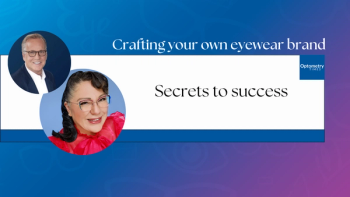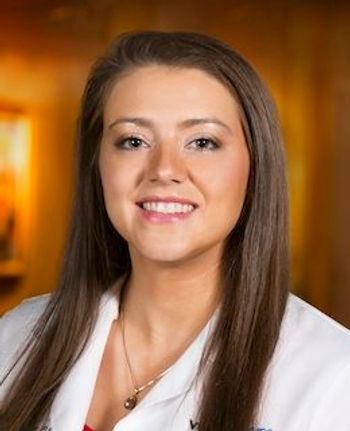
Sizing up daily disposable contact lenses
Most ODs could list all the missing items in their contact lens supply line. They could construct a wish list of products they would like to see available in the future. On days when we find ourselves ransacking the contact lens trial room, ODs may think technology is moving too slowly. Perhaps it’s time for some needed perspective.
Most ODs could list all the missing items in their contact lens supply line. They could construct a wish list of products they would like to see available in the future. On days when we find ourselves ransacking the contact lens trial room, ODs may think technology is moving too slowly. Perhaps it’s time for some needed perspective.
Considering it took over 400 years to get Leonardo da Vinci’s concept of contact lenses to materialize, it’s easy to see the speed at which the ophthalmic industry is introducing new technology and expanding the category.1
We have many forward thinking ODs in our profession who are not afraid to be the early adaptors, but the early adaption phase is over. It’s time for us to welcome a modality that will bring greater benefit to our patients, our practice, and our industry.
Previously from Dr. Brimer:
Evolution of daily disposables
In the U.S. market, it took 16 years (1971 to 1987) to go from the first soft contact lens to a disposable soft contact lens. In 1996, the first daily disposable (DD) soft contact lens was introduced (Acuvue, Johnson & Johnson Vison Care).1
It took 31 years to make major advancements in oxygen transmissibility of the soft lens. In 2002, Alcon released the first silicone hydrogel (sihy) lens-Focus Night & Day.1
Related:
Eight years later, Johnson & Johnson Vision Care expanded the sihy technology to a daily disposable modality with Acuvue TruEye. In 2017, we now we have eight daily disposable sihy lenses on the market.
When put into perspective, the rate of advancement in DD contact lenses is encouraging. As long as we embrace the new generation of lenses currently available to us, the possibilities of future technologies are limitless.
By fitting our patients with the newest technologies, we generate a demand in the marketplace for the perpetual release of such technology. This buy in feeds the contact lens companies with the funding needed to reinvest in research and development for new products. It also sets a precedent that ODs are inviting advancements, and we will not be afraid to incorporate these advancements into our practice.
I remember when the first sihy lens came out and the price tag that was associated with it. That same sticker shock came again with the first sihy DD. ODs have a reputation for being cost conscious for their patients. I often hear doctors say, “Patients won’t pay for that!” In fact, patients will pay for the newest technology and benefits-that is what allows us to expand our arsenal.
My practice is over 90 percent daily disposables, and the majority of those patients are fit with sihy lenses. There are tremendous health and convenience value to having a clean, fresh, wet lens with high oxygen transmissibility each day. Not only is it our job to present that to the patient, it is our obligation to help move the industry forward.
There are a few early adapting ODs who confidently recommend to their patients what they want them to wear and why. Then there is the majority of ODs who get on board later-once the product is proven and here to stay.
Any market analysis will show fitting and spending trends have changed over the past decade. The DD market is on the rise and boasts the highest trajectory of growth vs. any other modality.2 Let’s get familiar with some of the new DD lenses, and how they compare to the historical giants.
Related:
Daily disposables on the market
There are many ways to order current DDs, but perhaps by
The lens with the highest Dk is Alcon’s Dailies Total 1 (delfilcon A) with a Dk of 140. Alcon prides itself on Dailies Total 1 being the world’s only water gradient lens.3 The core is 33 percent water, but the surface is essentially absent of silicone with a water content of over 80 percent. Its sphere powers are available in -12.00 D to +6.00 D. While there is no toric design, Dailies Total 1 is available in a near centered multifocal design from -10.00 D to +6.00 D with a low, medium, or high add. Available base curves are 8.5 mm or 9.0 mm.
Wholesale pricing for Acuvue’s latest sihy DD release, Oasys 1-Day (delfilcon A; Dk 103), is neck and neck with Dailies Total 1. Oasys 1-Day has a water content of 38 percent. Powers range from +0.50 D to +8.00 D, and base curves are 8.5 mm or 9.0 mm.
Johnson & Johnson Vision Care’s original sihy release, TruEye (narafilcon A), has similar values with a Dk of 100, water content of 46 percent, and in sphere powers from -12.00 D to +6.00 D.
As ODs, we know there is much more to comfort and vision than just the material and stats.
When Johnson & Johnson Vision Care released TruEye as the first sihy DD in 2010, its claim to fame was obvious. Five years later, the company created an improved sihy DD lens by enlarging the optics and diameter (increased by 0.1 mm to 14.3 mm), in an attempt to provide better scotopic vision. Oasys 1-Day also has HydraLuxe technology incorporated-to create a more comfortable “tear-infused lens.”4
CooperVision’s MyDay with a Dk of 100 is a stenfilcon A lens that has a water content of 54 percent and is available in powers of -12.00 D to +8.00 D. The material utilizes Smart Silicone-which, according to the company, maximizes the permeability of the lens. With only 4.4 percent silicon, MyDay can hold more water, which is known to enhance patient comfort. 5
Clariti 1 day DD is the final sihy. While the Dk/t is notably lower at 60, CooperVision says the material (somofilcon A) allows “100 percent corneal oxygen consumption.” It is offered at a price point that matches or beats some of the traditional HEMA DD lenses.6,7 Clariti 1 day DD lens is also available in both a toric and near-centered multifocal design. This makes clariti the only sihy DD lens ODs can prescribe without combining brands or switching them out entirely.
Related:
Other DD options
There are also several non-silicone hydrogel DD lenses that have proven to be valuable. Despite having lower oxygen transmissibility, these lenses do hold some advantages. They often have better pricing and parameter availability (torics and multifocals) because they have been on the market longer.
If you are not currently fitting DDs, non-sihy daily disposable lenses are an easy way to start. Each of the big four contact lens companies has a traditional DD lens. Fortunately, all four brands now have multifocal versions, and three of the four brands have a toric design.
Bausch + Lomb’s Biotrue, Biotrue ONEday for Presbyopia, and Biotrue ONEday for Astigmatism have the highest Dk (42) and highest water content (78 percent) of the non-SiHy lenses. Alcon’s Dailies AquaComfort Plus has the most expansive powers ranging from -15.00 D to +8.00 D in sphere, -6.00 D to +4.00 D in toric, and -10.00 D to +6.00 D in multifocal. Acuvue 1-Day Moist is the only mainstream traditional DD available in two base curves (8.5mm and 9.0 mm).
Many ODs have used CooperVision’s Proclear as a standard issue for their dry eye patients due to its indication. According to CooperVision’s website, Proclear lenses are the only contacts cleared by the U.S. FDA for the claim, “may provide improved comfort for contact lens wearers who experience mild discomfort or symptoms relating to dryness during lens wear.”8
Future of daily disposable
The expansion of our DD sihy lenses is in our hands as ODs. Currently, we have only one sihy DD toric option and two multifocal options. These specialty sihy DD have the highest price tags, so ODs may need to spend time educating patients on their benefits.
The faster we embrace new daily disposable technology, the faster our industry will respond. Utilizing these technologies will lead to expanded parameter availability-as well as the introduction of new technology into the marketplace.
In turn, the more money contact lens manufacturers devote to research and development, the more products we will have at our fingertips. This means the ability to provide better care for our patients.
Related:
References:
1. GP Contact Lenses. A Brief History of Contact Lenses. Available at: http://www.contactlenses.org/timeline.htm. Accessed May 8, 2017.
2. Morgan P, Woods C, Tranoudis I, Helland M, Efron N, Jones, L, et al. International Contact Lens Prescribing in 2016. Contact Lens Spectrum. 2017 Jan;(32):30-35.
3. Bailey G. Alcon previews water-gradient contact lens. Optometry Times. 2013 Mar. Available at: http://optometrytimes.modernmedicine.com/optometrytimes/news/user-defined-tags/dailies-total-1/alcon-previews-water-gradient-contact-lens. Accessed May 17, 2017.
4. Johnson & Johnson Vision Care, Inc. Acuvue Oasys with Hydraluxe 1-day. Available at: http://www.acuvueprofessional.com/product/acuvue-oasys-1-day-with-hydraluxe. Accessed May 8, 2017
5. CooperVision. MyDay. Available at: http://coopervision.com/practitioner/our-products/myday/myday. Accessed May 8, 2017.
6. CooperVision. Clariti 1 day family. Available at: https://coopervision.com/sites/coopervision.com/files/1303_clariti_sell_sheet_updated_7-15.pdf. Accessed May 8, 2017.
7. Brennan NA. Beyond flux: total corneal oxygen consumption as an index of corneal oxygenation during contact lens wear. Optom Vis Sci. 2005 Jun;82(6):467–472.
8. CooperVision. Proclear family. Available at: http://coopervision.com/contact-lenses/proclear-family. Accessed May 8, 2017.
Newsletter
Want more insights like this? Subscribe to Optometry Times and get clinical pearls and practice tips delivered straight to your inbox.


















































.png)


